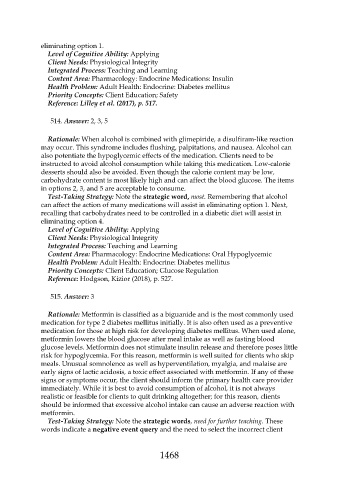Page 1468 - Saunders Comprehensive Review For NCLEX-RN
P. 1468
eliminating option 1.
Level of Cognitive Ability: Applying
Client Needs: Physiological Integrity
Integrated Process: Teaching and Learning
Content Area: Pharmacology: Endocrine Medications: Insulin
Health Problem: Adult Health: Endocrine: Diabetes mellitus
Priority Concepts: Client Education; Safety
Reference: Lilley et al. (2017), p. 517.
514. Answer: 2, 3, 5
Rationale: When alcohol is combined with glimepiride, a disulfiram-like reaction
may occur. This syndrome includes flushing, palpitations, and nausea. Alcohol can
also potentiate the hypoglycemic effects of the medication. Clients need to be
instructed to avoid alcohol consumption while taking this medication. Low-calorie
desserts should also be avoided. Even though the calorie content may be low,
carbohydrate content is most likely high and can affect the blood glucose. The items
in options 2, 3, and 5 are acceptable to consume.
Test-Taking Strategy: Note the strategic word, most. Remembering that alcohol
can affect the action of many medications will assist in eliminating option 1. Next,
recalling that carbohydrates need to be controlled in a diabetic diet will assist in
eliminating option 4.
Level of Cognitive Ability: Applying
Client Needs: Physiological Integrity
Integrated Process: Teaching and Learning
Content Area: Pharmacology: Endocrine Medications: Oral Hypoglycemic
Health Problem: Adult Health: Endocrine: Diabetes mellitus
Priority Concepts: Client Education; Glucose Regulation
Reference: Hodgson, Kizior (2018), p. 527.
515. Answer: 3
Rationale: Metformin is classified as a biguanide and is the most commonly used
medication for type 2 diabetes mellitus initially. It is also often used as a preventive
medication for those at high risk for developing diabetes mellitus. When used alone,
metformin lowers the blood glucose after meal intake as well as fasting blood
glucose levels. Metformin does not stimulate insulin release and therefore poses little
risk for hypoglycemia. For this reason, metformin is well suited for clients who skip
meals. Unusual somnolence as well as hyperventilation, myalgia, and malaise are
early signs of lactic acidosis, a toxic effect associated with metformin. If any of these
signs or symptoms occur, the client should inform the primary health care provider
immediately. While it is best to avoid consumption of alcohol, it is not always
realistic or feasible for clients to quit drinking altogether; for this reason, clients
should be informed that excessive alcohol intake can cause an adverse reaction with
metformin.
Test-Taking Strategy: Note the strategic words, need for further teaching. These
words indicate a negative event query and the need to select the incorrect client
1468

